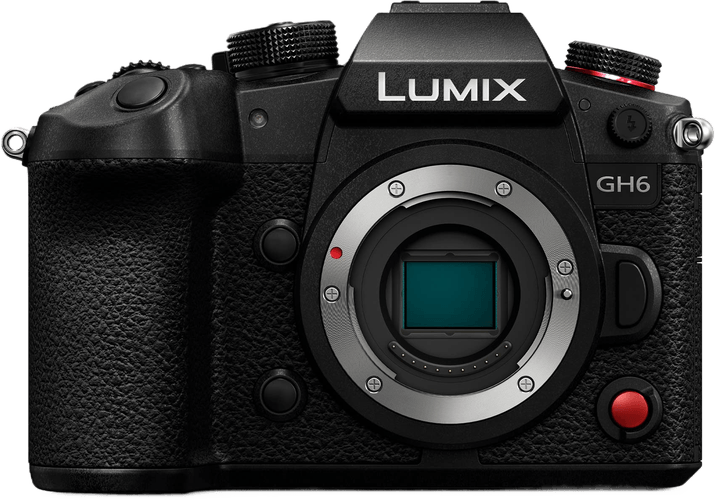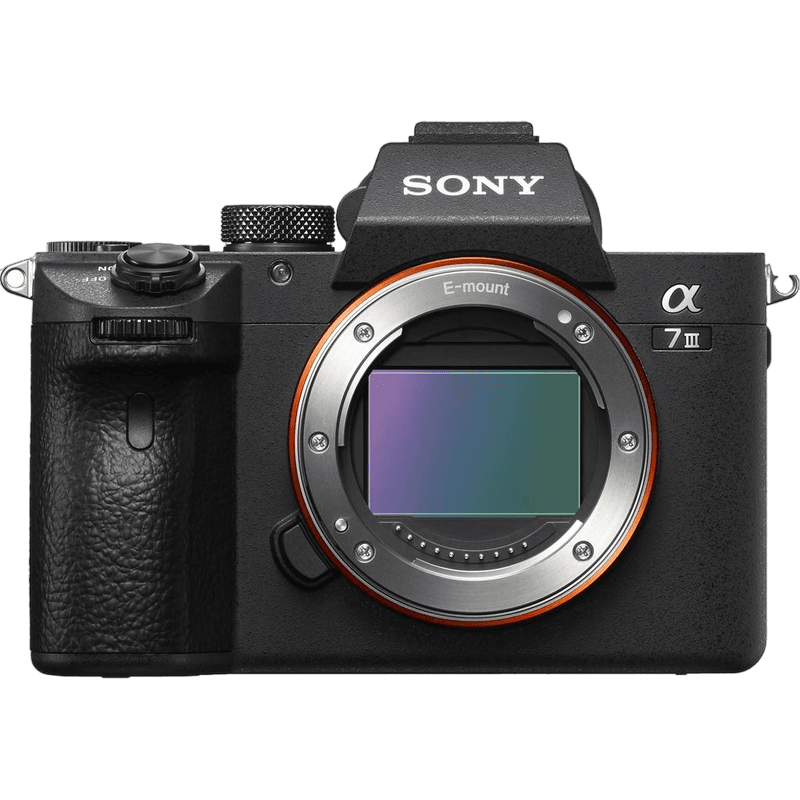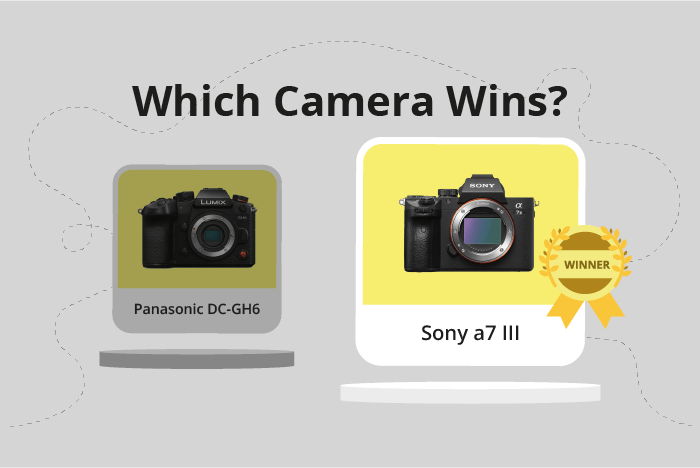Panasonic Lumix DC-GH6 vs Sony a7 III Comparison
Panasonic Lumix DC-GH6

Sony a7 III

The Panasonic Lumix DC-GH6 and the Sony a7 III are both mirrorless cameras, with the Sony a7 III taking the lead with a score of 81 compared to the Panasonic GH6’s 73. Both cameras were announced in February, with the GH6 in 2022 and the a7 III in 2018. In terms of size and weight, the GH6 measures 138 x 100 x 100mm and weighs 823g, whereas the a7 III is smaller and lighter at 127 x 96 x 74mm and 650g.
The Sony a7 III outshines the Panasonic GH6 in several aspects, which contribute to its higher score. The a7 III’s compact size and lighter weight make it more portable and comfortable to use during longer shooting sessions. Additionally, the lower price tag is likely to attract more budget-conscious photographers.
On the other hand, the Panasonic GH6, despite its lower score, has some advantages over the Sony a7 III. Being a newer release, the GH6 may offer more advanced features and improved performance. Furthermore, the larger size might provide better ergonomics for some users, depending on their preferences.
Taking all these factors into consideration, the Sony a7 III is the better camera due to its higher score, compact size, lighter weight, and lower price. However, the Panasonic GH6 remains a strong contender, especially for those who value its newer release and potential for advanced features.
Panasonic Lumix DC-GH6 vs Sony a7 III Overview and Optics
The Sony a7 III triumphs over the Panasonic Lumix DC-GH6 in optics, scoring 81/100 compared to the GH6’s 69/100. Both cameras share similarities, such as CMOS sensors, image stabilisation, and lens mounts. However, each camera excels in different areas, contributing to their overall scores.
The GH6 boasts a slightly higher megapixel count at 25, compared to the a7 III’s 24.2, and a faster shooting speed of 14 frames per second versus the a7 III’s 10. These factors give the GH6 an advantage in capturing high-resolution images at a rapid pace, making it ideal for action photography. The GH6 also has a Venus Engine processor, Micro Four Thirds sensor size, and a Micro 4/3 lens mount.
On the other hand, the Sony a7 III outshines the GH6 with its impressive DXOMARK sensor score of 96, significantly higher than the GH6’s 71. This indicates superior image quality and low-light performance. The a7 III also features a full-frame sensor, providing a larger field of view and better image quality than the GH6’s Micro Four Thirds sensor. Additionally, the a7 III utilizes a Bionz X processor and a Sony FE lens mount.
Considering these factors, the Sony a7 III emerges as the better option for those seeking superior image quality and low-light performance, while the Panasonic GH6 may be preferable for action photography due to its faster shooting speed. The choice ultimately depends on the individual’s priorities and needs in a camera.
Panasonic Lumix DC-GH6 vs Sony a7 III Video Performance
The Panasonic Lumix DC-GH6 outperforms the Sony a7 III in video capabilities, with a score of 96 versus the Sony’s 70. This significant difference in scores shows the superiority of the GH6 in terms of video performance.
Both cameras share some common video specifications, such as offering 4K resolution. However, the GH6 surpasses the a7 III by providing a maximum video resolution of 6K and dimensions of 5760 x 2880. This higher resolution allows for more detailed and sharper video quality compared to the a7 III’s maximum resolution of 4K and dimensions of 3840 x 2160.
Additionally, the GH6 offers a higher maximum video frame rate of 120fps, which enables smoother and more dynamic slow-motion footage. In contrast, the a7 III has a maximum frame rate of just 30fps.
While the Sony a7 III falls short in these aspects, it still offers good video quality with its 4K resolution. However, it does not provide any unique advantages over the GH6 in terms of video performance.
Considering the higher video resolution, superior frame rate, and built-in time-lapse functionality, the Panasonic Lumix DC-GH6 is the clear winner in video capabilities. The Sony a7 III, though a decent option, does not match the GH6’s performance, making the GH6 a better choice for those prioritizing video quality and features.
Panasonic Lumix DC-GH6 vs Sony a7 III Features and Benefits
The Panasonic Lumix DC-GH6 takes the lead with a feature score of 83/100, while the Sony a7 III trails slightly behind with a score of 81/100. Both cameras share several similarities in their features. They both have a 3-inch screen size, touchscreen capabilities, flip screens, and lack GPS functionality. Additionally, both cameras are equipped with WIFI and Bluetooth connectivity.
The Lumix DC-GH6 outperforms the Sony a7 III in terms of screen resolution, with 1,240,000 dots compared to the a7 III’s 921,600 dots. This higher screen resolution provides sharper image previews and improved camera control, giving the GH6 a clear advantage in this aspect.
On the other hand, the Sony a7 III does not have any specific features that significantly surpass the Lumix DC-GH6. The difference in their feature scores is minimal, and the a7 III does not possess any standout attributes to claim superiority over the GH6 in this comparison.
In light of these points, it is evident that the Panasonic Lumix DC-GH6 offers better features than the Sony a7 III, particularly in screen resolution. The higher resolution allows for enhanced image previews and camera control, making it a more suitable choice for photographers who prioritize these aspects. While the Sony a7 III does not have any distinct advantages over the GH6, it is still a solid camera option with comparable features. However, the Lumix DC-GH6 ultimately emerges as the superior choice in this comparison.
Panasonic Lumix DC-GH6 vs Sony a7 III Storage and Battery
The Panasonic Lumix DC-GH6 and Sony a7 III share common specifications, such as having two memory card slots and Li-ion battery packs. However, there are differences that set them apart.
The Lumix DC-GH6 accepts SD (UHS-II compatible) and CFexpress B memory cards, offering faster write speeds and larger storage capacities. Additionally, it supports USB charging, providing more convenience and flexibility when powering the camera.
On the other hand, the Sony a7 III accepts SD / SDHC / SDXC and Memory Stick Duo / Pro Duo / Pro-HG Duo cards and excels in battery life, offering 750 shots compared to the GH6’s 360 shots per charge.
Alternatives to the Panasonic Lumix DC-GH6 and Sony a7 III
Are you still undecided about which camera is right for you? Have a look at these popular comparisons that feature the Panasonic Lumix DC-GH6 or the Sony a7 III:

